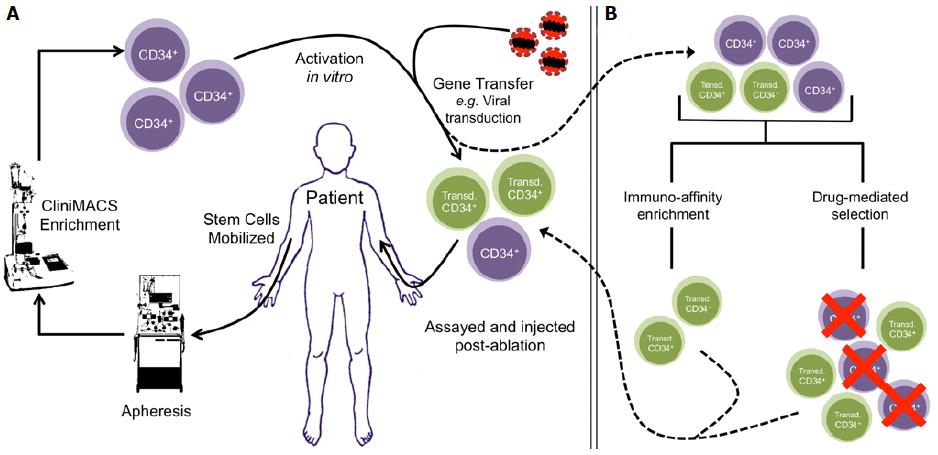Copyright
©The Author(s) 2015.
World J Stem Cells. Dec 26, 2015; 7(11): 1233-1250
Published online Dec 26, 2015. doi: 10.4252/wjsc.v7.i11.1233
Published online Dec 26, 2015. doi: 10.4252/wjsc.v7.i11.1233
Figure 1 General outline of ex vivo hematopoietic stem cell gene therapy and pre-selection methods.
A: CD34+ cells are enriched by CliniMACS after apheresis of peripheral blood of patients following mobilization. These cells are then briefly activated ex vivo and can be modified, commonly by viral transduction, to express a desired therapeutic protein. Cells are then assessed for quality control metrics and engrafted into patients following ablation; B: Pre-selection of transduced cells. Cells can be engineered to express an inert surface marker that can be used to immuno-enrich for the transduced population prior to engraftment. This strategy can increase the chances of hematopoietic reconstitution from the transduced population. Alternatively, cells can be given resistance to cytotoxic drugs. Pre-treatment of the cells ex vivo with drugs can kill off the non-transduced population. Ex vivo treatment allows the use of drugs that would normally not be efficacious in the bone marrow environment at a tolerable dose.
Figure 2 Summary of next-generation amplification modules.
A: Fusion proteins comprised of chemical inducer of dimerizations (CBDs) such as FKBP12 (WT CBD) or F36V (Mut CBD) and receptors involved in hematopoietic stem cells (HSC) growth, proliferation, and survival. Activation of signaling by CIDs allows expansion of the transduced population. The use of cytotoxic CIDs (CIDTOX) can allow simultaneous depletion of the non-transduced population. FK1012 is a putative cytotoxic CID-binding domain. Examples of inert or neutral CIDs (CIDNEU) include AP20187 and AP1903; B: Controlled overexpression of HSC homing and adhesion molecules can increase the potential for therapeutic cells to survive and can promote long-term engraftment. Examples of such molecules include but are not limited to CXCR4, VLA4, and Tie2. Their corresponding ligands (SDF-1, VCAM-1, and Ang-1, respectively) are usually expressed on osteoblasts, osteoclasts, MSCs, and other cells that make up the bone marrow stroma; C: Downstream effectors of key signaling pathways involved in maintaining HSC phenotypes that are down-regulated during ex vivo handling of CD34+ cells can be reconstituted to prevent stem cell exhaustion and to increase long-term engraftment of transduced cells. HoxB4 is an example of a transcription factor that is activated in response to Wnt signaling and is key to maintenance of the stem phenotype of HSCs.
- Citation: Nagree MS, López-Vásquez L, Medin JA. Towards in vivo amplification: Overcoming hurdles in the use of hematopoietic stem cells in transplantation and gene therapy. World J Stem Cells 2015; 7(11): 1233-1250
- URL: https://www.wjgnet.com/1948-0210/full/v7/i11/1233.htm
- DOI: https://dx.doi.org/10.4252/wjsc.v7.i11.1233














